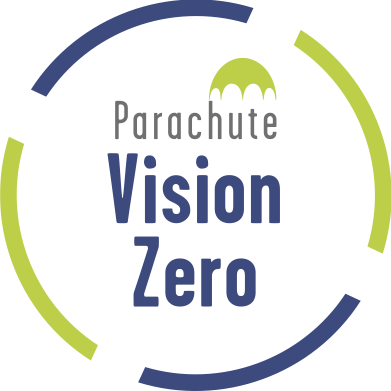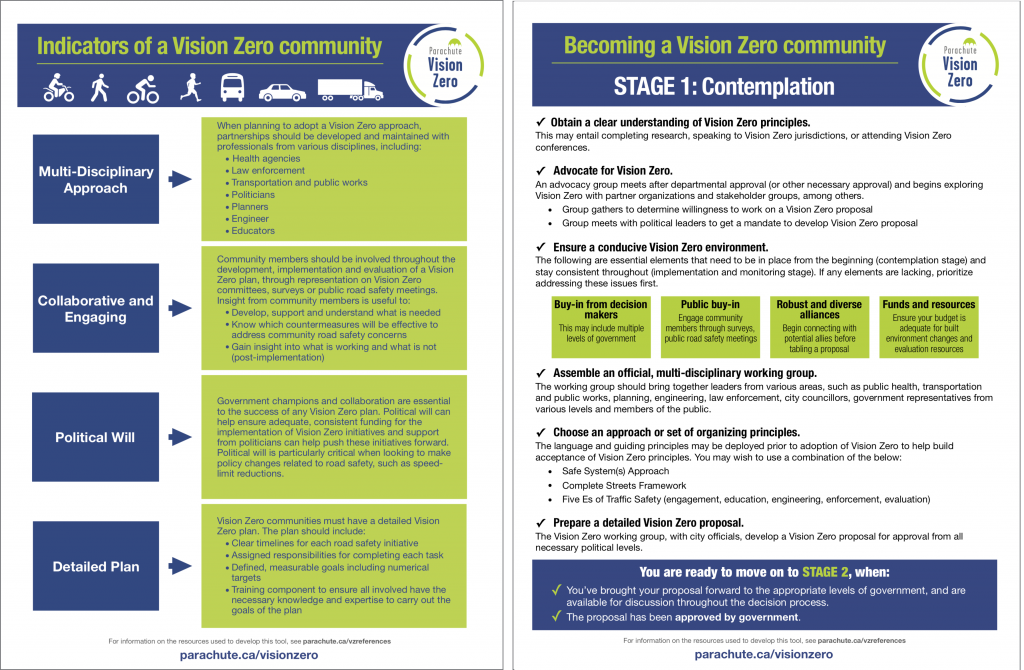Information on research referred to in the Parachute infographics series and other Parachute Vision Zero tools.
March 2023
Safe Mobility infographic series
Parachute. (2022). Parachute Vision Zero: Canadian Landscape 3.0. https://parachute.ca/wp-content/uploads/2022/06/CS12-Landscape-3.0-VZ-UA.pdf
Parachute. (2021). Multi-modal transportation: Making the link between climate action and road safety. https://parachute.ca/wp-content/uploads/2021/01/CS10-VZ-Climate-Change-and-Road-Safety-UA.pdf
Parachute. (2022). Change for Good Roads. https://parachute.ca/wp-content/uploads/2022/02/Parachute_CFGR_Report_EN-UA.pdf

February 2020
These resources have been developed based on, and with credit to, Vision Zero tools, papers and information from experts, including the below, as well as various road safety plans from around the world and feedback from road safety experts.
Milligan, C., & Peterniak, R. (2015). Vision Zero: Principles and checklist for effective adoption [PDF File]. Retrieved from https://janicelukes.ca/wp-content/uploads/2016/12/Milligan-and-Peterniak-2015-Vision-Zero-principles-for-effective-adoption.pdf.
Prevention Insitute. (n.d.). Vision Zero: A Health Equity Road Map for Getting to Zero in Every Community [PDF File]. Retrieved from https://www.preventioninstitute.org/sites/default/files/publications/Vision%20Zero%20-%20A%20Health%20Equity%20Road%20Map%20for%20Getting%20to%20Zero%20in%20Every%20Community%20FINAL.pdf.
Vision Zero Network. (2015). 9 Components of a Strong Vision Zero Commitment [PDF File]. Retrieved from: https://visionzeronetwork.org/wp-content/uploads/2018/05/VZN-9-Components.pdf.
Vision Zero Network. (2017). Vision, Strategies, Action: Guidelines for an Effective Vision Zero Action Plan [PDF File]. Retrieved from https://visionzeronetwork.org/wp-content/uploads/2017/12/VZN_ActionPlan_FINAL.pdf.
Vision Zero Network. (2018). Core Elements for Vision Zero Communities [PDF File]. Retrieved from https://visionzeronetwork.org/wp-content/uploads/2018/11/VZN_CoreElements_FINAL.pdf.
Vision Zero Network. (n.d.-a). Moving from Vision to Action: Fundamental Principles, Policies & Practices to Advance Vision Zero in the U.S. [PDF File]. Retrieved from: http://visionzeronetwork.org/wp-content/uploads/2017/01/MinimumElements_Final.pdf.
Vision Zero Network. (n.d.-b). Vision Zero Equity Strategies for Practitioners [PDF File]. Retrieved from http://visionzeronetwork.org/wp-content/uploads/2017/05/VisionZero_Equity.pdf.
World Resources Institute. (2018). Sustainable & Safe: A Vision and Guidance for Zero Road Deaths [PDF File]. Retrieved from: https://wriorg.s3.amazonaws.com/s3fs-public/sustainable-safe.pdf?_ga=2.111618630.330258175.1559238850-70055699.1559238850.
June 2018
Safe Schools
- Most collisions within school zones occur at midblock locations versus intersections.
SOURCE: Warsh, J., Rothman, L., Slater, M., Steverango, C., Howard, A. (2009). Are school zones effective? An examination of motor vehicle versus child pedestrian crashes near schools. http://injuryprevention.bmj.com/content/15/4/226.short
- Presence of sidewalks and multi-use walkways increases active transportation.
SOURCE: Oluyomi, A. O. et al. (2014). Parental safety concerns and active school commute: correlates across multiple domains in the home-to-school journey. Int. J. Behav. Nutr. Phys. Act. 11, 32. https://www.ncbi.nlm.nih.gov/pmc/articles/PMC3975836/
- Speed humps are effective at reducing child pedestrian collisions. Other examples include traffic circles or pinch points.
SOURCE: Rothman, L., Macpherson, A., Buliung, R., Macarthur, C., To, T., Larsen, K., Howard, A. (2015). Installation of speed humps and pedestrian-motor vehicle collisions in Toronto, Canada: a quasi-experimental study. https://www.ncbi.nlm.nih.gov/pmc/articles/PMC4534084/
- Pedestrians have been shown to have a 90% chance of survival when struck by a car travelling at 30 km/h or below, but less than 50% chance of surviving an impact at 45 km/h.
SOURCE: World report on road traffic injury prevention (http://www.who.int/violence_injury_prevention), World Health Organization
- Dangerous driving behaviours in and around student drop-offs increase the risk of pedestrian motor vehicle collisions.
SOURCE: Panel discussion on traffic safety in school zones. Gail Robertson, Road Safety Amabassador, Insurance Hunter.ca, Linda Rothman, Hospital for Sick Children, Jennifer Reynolds, Editor-in-Chief, Canadian Family, and Police Constable Hugh G. Smith from the Toronto Police Service, Traffic Services.
https://helpwevegotkids.com/national/article/parenting_101/school-zone-traffic-safety/
March 2018
Teen beliefs about cannabis and driving
- The “what teens think” quotes/messages are based on a qualitative study by CCSA to examine what common misconceptions are held by Canadian youth about cannabis and its harms: McKiernan, A., & Fleming, K. (2017) Canadian Youth Perceptions on Cannabis, Ottawa, Ont.: Canadian Centre on Substance Abuse.
- “Cannabis doubles the risk of being in a serious crash.”
SOURCE: Cannabis, Driving and Implications for Youth: Canadian Centre on Substance Abuse.
- “Cannabis can reduce your ability to concentrate…”
SOURCE: Drug-Impaired Driving in Canada: Educator Toolkit: Canadian Centre on Substance Abuse
- “Nearly one-third of drivers who die in a crash test positive for cannabis.”
SOURCE: Woodall, K.L., Chow, B.L., Lauwers, A., Cass, D. (2015). Toxicological findings in fatal motor vehicle collisions in Ontario, Canada: a one-year study. Journal of Forensic Science, 60(3), 669-74.
- “Police report nearly 3,000 drug-impaired riving incidents per year.”
SOURCE: Impaired driving in Canada, 2015: Statistics Canada
September 2017
Collision avoidance technologies
SOURCE for all items: Jermakian, J. S. (2011). Crash Avoidance Potential of Four Passenger Vehicle Technologies. Accident Analysis & Prevention, 43(3), 732-740.
June 2017
Complete rural roads
- “2+ 1 roads with a cable barrier can reduce fatal collisions and serious injuries by 55%”
SOURCE: Transportation Research Board of the National Academies (2003). Application of European 2+1 Roadway Designs. Research Results Digest, 275, 1-31.
“Roundabouts can reduce the risk of fatal crashes by 50-70%”
SOURCES: Elvik, R. (2003). Effects on Road Safety of Converting Intersections to Roundabouts: Review of Evidence from Non-U.S. Studies. Transportation Research Record: Journal of the Transportation Research Board, 1847.
Elvik, R. (2017). Road safety effects of roundabouts: A meta-analysis. Accident Analysis Prevention 99 (Pt A), 364-371.
- “Street lighting at rural intersections can reduce night-time crashes by 25-40%”
SOURCE: Preston, H., & Schoenecker, T. (1999). Safety Impacts of Street Lighting at Isolated Rural Intersections (Report No. 1999-17). Minnesota Department of Transportation, St. Paul MN. Retrieved from http://www.lrrb.org/media/reports/199917.pdf
- “Rumble strips can reduce run-off-road collisions by up to 36%”
SOURCE: Longitudinal Rumble Strips and Stripes on 2-Lane Roads – Proven Safety Countermeasures. (2014). U.S. Department of Transportation Federal Highway Administration. Retrieved from https://safety.fhwa.dot.gov/provencountermeasures/fhwa_sa_12_008.cfm
Note:
This infographic uses the definition for rural roads provided by Transport Canada and the Canadian Council of Motor Transport Administrators (CCMTA), including:
(a) primary or secondary highways, as well as local roads, or
(b) a speed limit at the collision site exceeding 60 km/h.
In Alberta, New Brunswick, Manitoba, and Saskatchewan “urban” includes any area within the corporate boundaries of a city, town, village or hamlet and “rural” includes any area outside of what is defined as “urban.”
May 2017
Complete urban streets
- “Protected bike lanescan reduce vehicle-bicycle crashes resulting in injuries by as much as 90%”
- “Advance stop linescan increase the likelihood of drivers yielding to pedestrians crossing by approximately 60%”
- “Pedestrian/raised refuge islands: can reduce vehicle-pedestrian crashes by 46%”
SOURCE: B.C. Community road safety toolkit resource kit module 1: Protecting people who walk and cycle
- “Protected left-turns can reduce left-turn collisions by up to 99%”
SOURCE: Halton active transportation master plan 2015: Design toolbox
